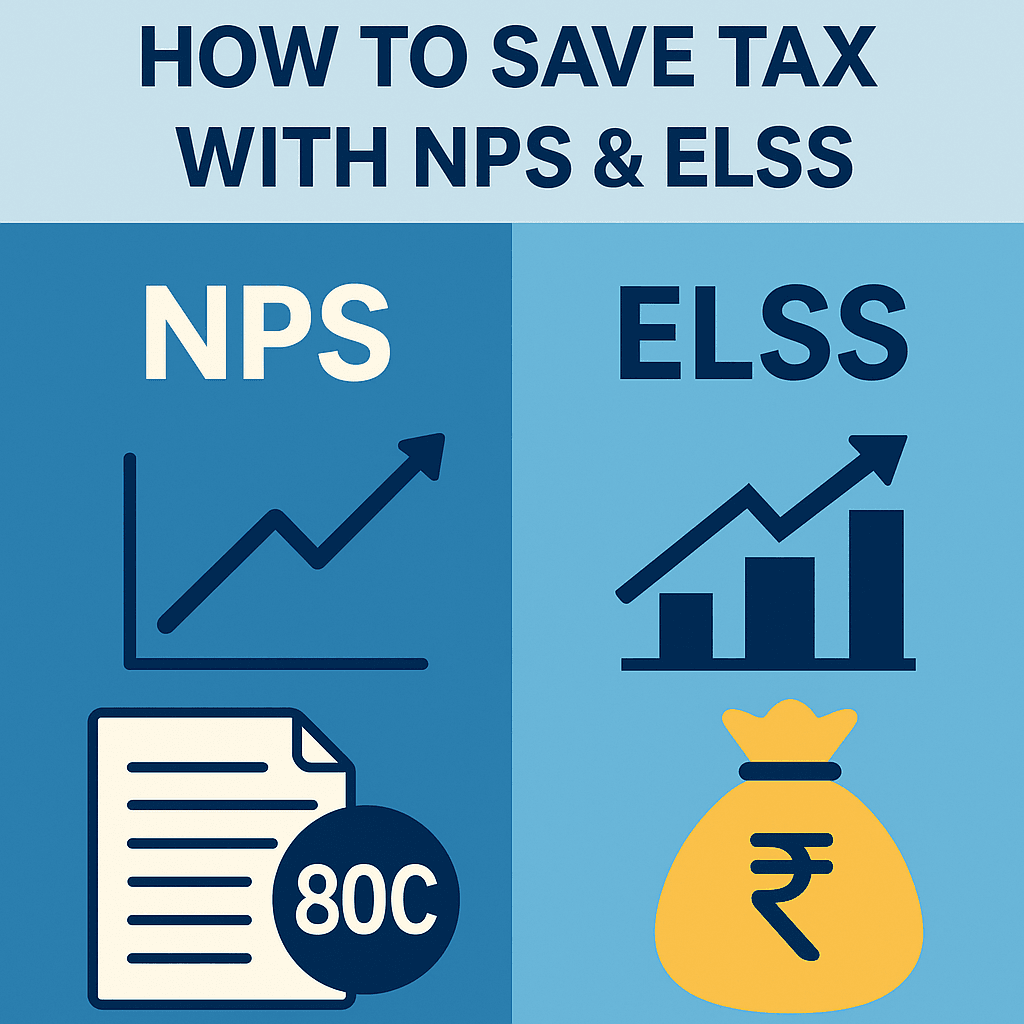Last Updated on August 14, 2025 8:37:43 PM by Vivek Makwana
Discover how to save tax in India using NPS and ELSS. Learn about Section 80C, 80CCD benefits, lock-in periods, returns, and smart investment strategies for 2025.
How To Save Tax With NPS & ELSS
Saving tax is one of the most important goals for every taxpayer, especially salaried professionals and self-employed individuals. While there are many tax-saving instruments available in India, two of the most popular options are NPS (National Pension System) and ELSS (Equity-Linked Savings Scheme). Both offer excellent tax benefits, but they work differently in terms of returns, lock-in period, and risk. In this guide, we will explore how you can use both NPS and ELSS to save tax efficiently while also growing your wealth.
What Is NPS?
National Pension System (NPS) is a government-backed retirement savings scheme. It allows you to invest regularly during your working life and get a pension after retirement. It is regulated by the PFRDA (Pension Fund Regulatory and Development Authority).
Key Features of NPS:
- Long-term retirement planning tool
- Low-cost investment option
- Offers both equity and debt exposure
- Lock-in period till age 60
- Partially tax-free withdrawals
What Is ELSS?
Equity-Linked Savings Scheme (ELSS) is a tax-saving mutual fund that invests primarily in equity markets. It is one of the few market-linked instruments that qualifies for tax deduction under Section 80C of the Income Tax Act.
Key Features of ELSS:
- Market-linked returns
- Short lock-in period of 3 years
- High return potential compared to traditional instruments
- Managed by professional fund managers
- Comes with growth and dividend options
Tax Benefits of NPS
1. Section 80CCD(1):
You can claim deduction up to 10% of salary (Basic + DA) or 20% of gross income (for self-employed), subject to a maximum of ₹1.5 lakh under Section 80C combined limit.
2. Section 80CCD(1B):
An additional deduction of ₹50,000 is available over and above 80C. This means you can claim up to ₹2 lakh in total (₹1.5 lakh under 80C + ₹50,000 under 80CCD(1B)).
3. Employer Contribution:
If your employer contributes to NPS on your behalf, that amount (up to 10% of your salary) is also tax-free under Section 80CCD(2). This benefit is over and above the ₹2 lakh limit.
Tax Benefits of ELSS
1. Section 80C Deduction:
You can claim a deduction of up to ₹1.5 lakh in a financial year. This can help you save up to ₹46,800 in taxes (if you’re in the 30% tax bracket).
2. Tax on Returns:
ELSS returns are subject to Long-Term Capital Gains (LTCG) tax. Gains up to ₹1 lakh per financial year are tax-free. Gains above ₹1 lakh are taxed at 10% without indexation.
NPS vs ELSS – Which Is Better?
| Feature | NPS | ELSS |
|---|---|---|
| Tax Benefit | Up to ₹2 Lakh | Up to ₹1.5 Lakh |
| Lock-In Period | Till Retirement (Age 60) | 3 Years |
| Returns | 8–10% (Moderate Risk) | 12–15% (High Risk) |
| Liquidity | Low | High (After 3 Years) |
| Risk Level | Low to Moderate | High |
| Ideal For | Retirement Planning | Wealth Creation + Tax Saving |
How To Use Both NPS and ELSS for Maximum Tax Saving
Step 1: Invest ₹1.5 Lakh in ELSS
This fulfills your Section 80C limit. ELSS gives you the potential for higher returns and has a short lock-in of just 3 years.
Step 2: Invest ₹50,000 in NPS
This allows you to claim additional deduction under Section 80CCD(1B). It’s especially useful for people already exhausting their 80C limit.
Step 3: Ask Your Employer to Contribute to NPS
Employer contributions are not counted in your 80C or 80CCD(1B) limit. This is an additional tax-saving opportunity under Section 80CCD(2).
Example: How Much Tax Can You Save?
Let’s assume you are a salaried individual with a taxable income of ₹10 lakh per year.
- ₹1.5 lakh invested in ELSS → Saved up to ₹46,800 (under Section 80C)
- ₹50,000 invested in NPS → Saved up to ₹15,600 (under Section 80CCD(1B))
- Total Tax Saved = ₹62,400
If your employer also contributes ₹1 lakh to your NPS, that is tax-free for you under Section 80CCD(2).
Tips for Choosing Between NPS and ELSS
- Choose ELSS if you want higher returns, can take market risk, and want liquidity in the short to medium term.
- Choose NPS if you are focused on long-term retirement planning and want to lower your tax liability even more.
- Use Both if you want to maximize deductions under both Section 80C and Section 80CCD(1B).
Conclusion
Both NPS and ELSS are excellent tax-saving instruments that serve different purposes. While ELSS is great for short-term wealth creation with high returns, NPS is a stable, long-term option for retirement planning. By using both smartly, you can save up to ₹62,400 (or more) in taxes annually while also building a strong financial future.
Disclaimer: Tax rules and benefits mentioned in this article are subject to change as per government notifications and amendments. Readers are advised to consult a qualified tax advisor and refer to the official Income Tax Department website or PFRDA website for the latest information before making any financial decisions.


